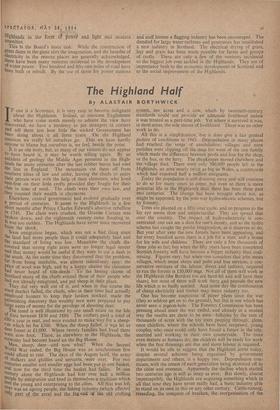The Highland Half
It is an old story, but, as many of our visitors do not appear to have heard it, it may be worth telling again. By an accident of geology the Middle Ages persisted in the High- lands for many centuries after the last robber baron had toed the line in England. The mountains cut them off from southern ideas of law and order, leaving the chiefs to enjoy their private wars with the help of their clansmen, who lived rent-free on their little crofts provided they fought for their Clan in time of need. The Chiefs were their, own law, and they counted their wealth in claymores.
Elsewhere, central government had evolved gradually over a period of centuries. It came to the Highlands in a few Short months after Prince Charles Edward's abortive rebellion in 1745. The clans were crushed, the Granite Curtain was broken down, and the eighteenth century came flooding in. tt was too sudden. The Highlands have never since recovered from the shock. system, ten acres and a cow, which by twentieth-century standards could not provide an adequate livelihood unless it was treated as a part-time job. Yet where it survived it was, in most areas, the sole means of livelihood. There was no other work to do.
All this is a simplification, but it does give a fair general picture of conditions in 1945. Depopulation in many places had reached the verge of annihilation: villages and even parishes were slipping off the map for want of the one family which made the difference between profit and loss for the shop, or the bus, or the ferry. The shopkeeper moved elsewhere and the village died. There were only 300,000 people left in the Highlands, an area'nearly twice, as big as Wales, a countryside which had exported half a million emigrants.
Today the population is still draining away and will continue to do so for many years to come; but even so there is more potential life in the Highlands than there has been these past two centuries. The change has been brought about not, as might be supposed, by the post-war hydro-electric schemes, but by forestry.
Trees are planted on a fifty-year cycle, and so progress to the lay eye seems slow and unspectacular. They are spread thin over the country. The impact of hydro-electricity is con- centrated: one can see a darn for one's money, and so the hydro scheme has caught the public imagination, as it deserves to do. But year after year the new forekts have been appearing, and for every hundred acres there is a job for a man, and a house for his wife and children. There are only a few thousands of these jobs so far; but when the fifty years have been completed Scottish forestry will have become a bigger industry than Coal- mining. Figures vary, but when one considers that jobs mean villages, which mean shops and pubs and bus services, a con- servative estimate of the labour, direct and indirect, required to run the forests is 150,000 men. Not all of ttiem will work in the Highlands (the Borders too are hard-hit and will have their share), but most of them will work there and provide the new life which is so badly needed. And some day the combination of cheap electricity and timber may mean industry too.
One has become suspicious of paper plans since the war (they so seldom get on to the ground), but this is one which has never seen a pigeon-hole. The Forestry Commission has been pressing ahead since the war ended, and already in a modest way the results are there to be seen--hillsides by the tens of thousands of acres with the toy trees peeping through: glens, once childless, where the schools have been reopened; young couples, who once could only have found a future in the city, married and working in their own countryside. The trees even mature as humans do: the children will be ready for work when the first thinnings are due and more labour is required, It would be idle to suggest that the Highland scene today, despite several schemes being organised by government departments and others, is a happy one. Depopulation con- tinues, with the cream of each generation being skirnmed oft to the cities and overseas, Apparently the decline which started two centuries ago is still as steep as ever. But slowly, almost imperceptibly, the Highlands are acquiring something which in all that time they have never really had, a basic industry able to stand on its own in this or any other century. Cattle-raising, reseeding, the conquest of bracken, the reorganisation of the
Crafting system—all these are being tried and all are important; but the real future of the Highlands lies with the least spectacu- lar of all the projects, forestry.



































































 Previous page
Previous page